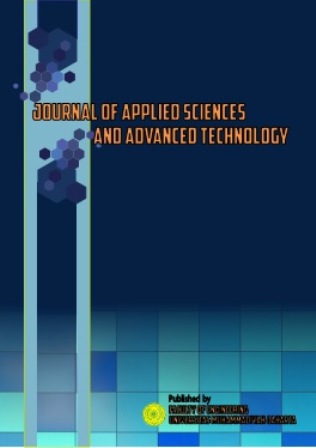Coal Fly Ash as Adsorbent in Removing Organic Compounds (COD) From Tanah Tinggi Wastewater Treatment Installation in Tangerang City
DOI:
https://doi.org/10.24853/jasat.5.2.59-66Keywords:
Coal Fly Ash Adsorption CODAbstract
Coal is a combustible organic mineral; the ash produced from burning coal is fly ash and bottom ash. This study aims to determine the process of treating fly ash waste from coal combustion by activating and characterizing it as an adsorbent and to obtain the best type of adsorbent with a concentration of coal fly ash as an adsorbent in removing organic compounds COD so that it meets the standards. Quality by accordance with the Regulation of the Minister of Environment and Forestry Number 68 of 2016 concerning Domestic Wastewater Quality Standards. The research will be carried out with 2 (two) processes, namely the process of making adsorbents and testing the application of fly ash adsorbents with variations in the concentration of sulfuric acid (H2SO4) 2.5%, 5%, and 10% and variations in stirring time of 60, 90, 120 and 150 minutes, then analyzed the COD (Chemical Oxygen Demand) content so that it meets the quality standards that have been set. The results showed that the fly ash content of coal has the potential to be used as an adsorbent because of the high SiO2 content of 35.8% and the Al2O3 content of 17.0%. Results The initial concentration of COD was 404 mg/l. The final concentration of COD for various stirring times with various H2SO4 activation was 11 mg/l with a stirring time of 150 minutes. Optimum conditions of removal efficiency (%) COD for variation of stirring time with various H2SO4 activation obtained 35.73%, R2 value = 0.9891, and the linear regression equation is y = 0.206x - 4.864 with the value of y is COD efficiency removal (%) and x is stirring time (minutes).Downloads
References
Adha, A., 2009, "The Effect of the Addition of Coal Ash (fly ash) in Peat Soil on Soil Bearing Capacity", Islamic University of Indonesia Civil Engineering and Planning Department of Civil Engineering, Yogyakarta.
Afrianita, Reri, et al, 2010, ”Coal Fly Ash as Adsorbent in Removal Coumpound Organic (COD) from Domestic Wastewater (Case Study : Inna Muara Hotel Liquid Waste, Padang)”, No.33 Vol.1 Thn.XVII, Andalas University.
Dwi Cahyono Ari and Agung R Tuhu , 2013 “Coal Fly Ash as Adsorbent in Removal Coumpound Organic (COD) from Domestic Wastewater Wonorejo Flats Surabaya”, Environmental Engineering Scientific Journal Vol. 4 No. 1, 2013 .
[Anonymous, 2008, “Coal Ash As Adsorbent”, majarimagazine.
Haryanti, Ninis Hadi, 2014, “Test of Fly Ash PLTU Asam Asam as Light Brick Making”, FLUX Physics Journal, Vol. 11 No. 2.
Irawan, C, et al, 2015, "Effect of Adsorbent Mass, Contact Time and Activation of Adsorbent Using HCl on the Effectiveness of Reduction of Heavy Metals (Fe) by Using Fly Ash as Adsorbent", Journal of Integrated Technology, Vol. 3 No. 2.
Kasam, et al, 2005, "Reduction of COD (Chemical Oxygen Demand) in Laboratory Liquid Waste Using Coconut Shell Charcoal Activated Carbon Filter", Logic, Vol.2. No.2 Department of Environmental Engineering FTSP UII.
Lasryza, Ayu and Dyah Sawitri. (2012), ” Coal Fly Ash as Adsorbent in CO2 Gas Emissions in Motor Vehicles”, POMITS Engineering Journal, Vol.1 No. 1.
Mufrodi, et al, 2010, "Modification of fly ash waste as a new adsorbent material", Paper presented in the Proceedings of the National Seminar on Chemical Engineering "Struggle". Ahmad Dahlan University.
Novia, et al, 2010, "Production of Adsorbent from Fly Ash from Coal Burning to Adsorb Iron Metal (Fe)", Department of Chemical Engineering, Sriwijaya University.
Tri Lestari Yuliani, 2013 “Coal Fly Ash as Adsorbent in for Determination of NO2 Gas Levels in the Air”, Chemical, FMIPA, Jember University.
Widiharti, I., A., G. 2008. Adsorpsi Anion Cr(VI) Oleh Batu Pasir Teraktivasi Asam Dan Tersalut Fe2O3
Government Regulation, 2021, Government Regulation Number 22 of 2021 concerning Environmental Protection and Management.
Regulation of the Minister of Environment and Forestry, 2016, Regulation of the Minister of Environment and Forestry Number P.68/Menlhk/Setjen/Kum.1/8/2016 concerning Domestic Wastewater Quality Standards.
Downloads
Published
Issue
Section
License
COPYRIGHT POLICY
The author(s) of an article published in the Journal of Applied Sciences and Advanced Technology (JASAT) retains ownership of the intellectual property rights in work (s).
PUBLISHING RIGHTS
The author(s) of an article published in the Journal of Applied Sciences and Advanced Technology (JASAT) have unrestricted publication rights. The authors give the Journal of Applied Sciences and Advanced Technology (JASAT) the right to publish the article and designate the Faculty of Engineering Universitas Muhammadiyah Jakarta Publishing as the original publisher of the article.
LICENSING POLICY
JASAT is an open-access journal that follows the Creative Commons Non-Commercial 4.0 International License (CC BY-NC 4.0), which states that:

Under this license, the reusers must give appropriate credit, provide a link to the license, and indicate if changes were made. Users may do so in any reasonable manner, but not in any way that suggests the licensor endorses users or their use.
Please take the time to read the whole license agreement (https://creativecommons.org/licenses/by-nc/4.0/). As long as reusers follow the license conditions, the owner cannot withdraw these freedoms. The following components are included under this license:
 Attribution: Users must provide appropriate attribution, including a link to the license, and indicate whether or not they made any modifications. Users are free to do so reasonably, but not in a manner that indicates the licensee approves of their usage.
Attribution: Users must provide appropriate attribution, including a link to the license, and indicate whether or not they made any modifications. Users are free to do so reasonably, but not in a manner that indicates the licensee approves of their usage.
 NonCommercial: Users may not use the material for commercial purposes.
NonCommercial: Users may not use the material for commercial purposes.












_2.png)


1.png)

2.png)
